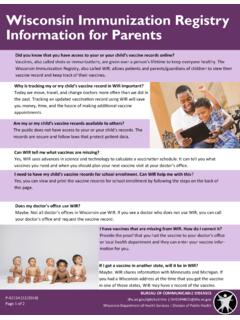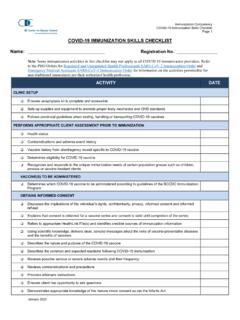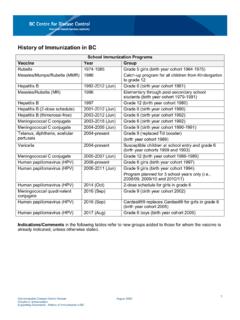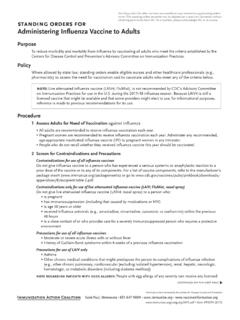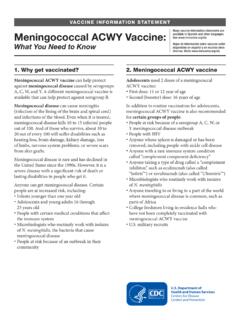Transcription of Infection Control and Sterile Technique
1 General Best Practice Guidelines for immunization : Vaccine Administration 88 6. Vaccine Administration Infection Control and Sterile Technique General Precautions Persons administering vaccinations should follow appropriate precautions to minimize risk for disease exposure and spread. Hands should be cleansed with an alcohol-based waterless antiseptic hand rub or washed with soap and water before preparing vaccines for administration and between each patient contact (1). Occupational Safety and Health Administration (OSHA) regulations do not require gloves to be worn when administering vaccinations, unless persons administering vaccinations have open lesions on their hands or are likely to come into contact with a patient s body fluids (2).
2 If worn, gloves should be changed between patients. Vaccine Administration: Preparation and Timely Disposal Vaccines should be drawn up in a designated clean medication area that is not adjacent to areas where potentially contaminated items are placed. Multi-dose vials to be used for more than one patient should not be kept or accessed in the immediate patient treatment area. This is to prevent inadvertent contamination of the vial through direct or indirect contact with potentially contaminated surfaces or equipment that could then lead to infections in subsequent patients (3).
3 Smallpox vaccine is accessed by dipping a bifurcated needle directly into the vaccine vial. The vaccine adheres to the sides of the bifurcated needle, and is administered via skin puncture. The vial must be accessed in the immediate patient area to reduce environmental contamination by vaccine virus. To prevent contamination of the vial, make sure the patient area is clean and free of potentially contaminated equipment. Different single-components of combination vaccines should never be mixed in the same syringe by an end-user unless specifically licensed for such use (4).
4 Single-dose vials and manufacturer-filled syringes are designed for single-dose administration and should be discarded if vaccine has been withdrawn or reconstituted and subsequently not used within the time frame specified by the manufacturer. Syringes that are prefilled by the manufacturer and activated ( , syringe cap removed or needle attached) but unused should be discarded at the end of the clinic day. For inactivated vaccines manufacturers, General Best Practice Guidelines for immunization : Vaccine Administration 89 typically recommend use within the same day that a vaccine is withdrawn or reconstituted.
5 For live vaccines that require reconstitution, manufacturers typically recommend the vaccine be used as soon as possible after reconstitution and be discarded if not used within 30 minutes after reconstitution. For example, varicella vaccine should be discarded if not used within 30 minutes after reconstitution, whereas MMR vaccine, once reconstituted, must be kept in a dark place at 36 F to 46 F (2 C to 8 C) and should be discarded within 8 hours if not used. When in doubt about the appropriate handling of a vaccine, vaccination providers should contact that vaccine s manufacturer.
6 ACIP discourages the routine practice of providers prefilling syringes for several reasons. Because the majority of vaccines have a similar appearance after being drawn into a syringe, prefilling might result in administration errors. Because unused prefilled syringes also typically must be discarded if not used within the same day that they are filled, vaccine wastage might occur. The FDA does not license administration syringes for vaccine storage. In certain circumstances in which a single vaccine type is being used ( , in preparation for a community influenza vaccination campaign), filling a small number (10 or fewer) of syringes may be considered (5).
7 The doses should be administered as soon as possible after filling, by the same person who filled the syringes. Unused syringes that are prefilled by the manufacturer and activated ( , syringe cap removed or needle attached) should be discarded at the end of the clinic day. Vaccine from two or more vials should never be combined to make one or more doses. This can lead to violation of expiration dates and product contamination (6,7). Health Care Provider Exposure to Vaccine Components Providers are sometimes concerned when they have the same contraindications or precautions as their patients from whom they withhold or defer vaccine.
8 For administration of routinely recommended vaccines, there is no evidence of risk of exposure of vaccine components to the health care provider, so conditions in the provider labeled as contraindications and precautions to a vaccine components are not a reason to withdraw from this function of administering the vaccine to someone else. Historic concerns about exposure to vaccine components are limited to non-parenteral vaccines in which some degree of environmental exposure is unavoidable (5, 8), or situations in which General Best Practice Guidelines for immunization : Vaccine Administration 90 self-inoculation is likely due to the nature of the vaccine microbe [ reduced attenuation of smallpox vaccine virus (9)].
9 Persons administering ACAM 2000 smallpox vaccine to laboratory and health care personnel at risk for occupational exposure to orthopoxviruses can decrease the risk for inadvertent Infection through recommended Infection prevention measures. However, because of a theoretical risk for Infection , vaccination with ACAM2000 can be offered to health care personnel administering this vaccine, provided individual persons have no specified contraindications to vaccination (10). Safe Use of Needles and Syringes Needles and syringes used for vaccine injections must be Sterile and disposable.
10 A separate needle and syringe should be used for each injection. Changing needles between drawing vaccine from a vial and injecting it into a recipient is not necessary unless the needle has been damaged or contaminated (11). Bloodborne diseases ( , hepatitis B, hepatitis C, human immunodeficiency virus [HIV]) are occupational hazards for clinicians and other health-care providers. The Needlestick Safety and Prevention Act (2) was enacted in 2000 to reduce the incidence of needlestick injury and the consequent risk for bloodborne diseases acquired from patients.










